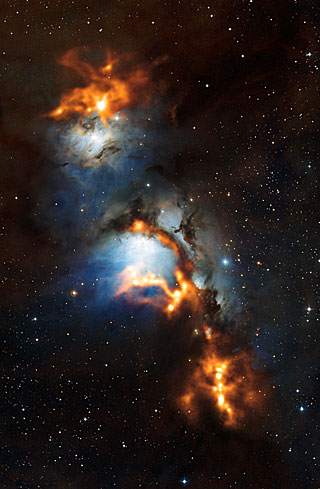A recently snapped image of the region surrounding the Messier 78 nebula, just to the north of Orion’s Belt, shows clouds of cosmic dust threaded through the nebula like a string of pearls.
The picture, captured by the Atacama Pathfinder Experiment (APEX) telescope, uses the heat glow of interstellar dust grains to show astronomers where new stars are being formed.

Indeed, the new image of Messier 78 and its surroundings reveals the submillimeter-wavelength radiation from dust grains in space and illustrates that dust can be dazzling.
Remember, dust is important to astronomers as dense clouds of gas and dust are the birthplaces of new stars.
In the center of the image is Messier 78, also known as NGC 2068. When seen in visible light, this region is actually classified as a reflection nebula, meaning that we see the pale blue glow of starlight reflected from clouds of dust.
The APEX observations are overlaid on the visible-light image in orange. Sensitive to longer wavelengths, they reveal the gentle glow of dense cold clumps of dust, some of which are even colder than -250ºC.
One filament observed by APEX appears in visible light as a dark lane of dust cutting across Messier 78 – indicating that dense dust lies in front of the reflection nebula, blocking its bluish light. Another prominent region of glowing dust seen by APEX overlaps with the visible light from Messier 78 at its lower edge. The lack of a corresponding dark dust lane in the visible light image implies the dense region of dust lies behind the reflection nebula.
Further observations of the clouds reveal gas flowing at high velocity out of some of the dense clumps. These outflows are ejected from young stars while the star is still forming from the surrounding cloud. Their presence likely means these clumps are actively forming stars.
At the top of the image is another reflection nebula, NGC 2071. While the lower regions in this image includes only low-mass young stars, NGC 2071 contains a more massive young star with an estimated mass five times that of the Sun, located in the brightest peak seen in the APEX observations.






